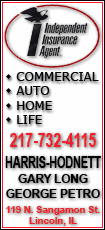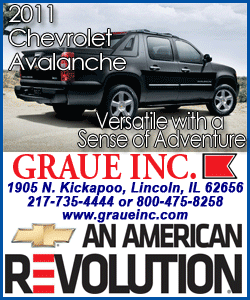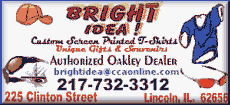 In addition to looking at the brick versus asphalt issue, the
council also discussed the downtown traffic signals and a parking
issue on South Sangamon that could be hindering the growth of a
local business. In addition to looking at the brick versus asphalt issue, the
council also discussed the downtown traffic signals and a parking
issue on South Sangamon that could be hindering the growth of a
local business.
Mayor suggests a "Brick Street Heritage" area
At last week's voting session, motions to approve bids on street
resurfacing projects were tabled so there could be further
discussion on what to do about the streets that are currently brick
surfaces, namely Pulaski and Sixth streets.
Tuesday evening Mayor Keith Snyder said he wanted to make a
suggestion for the council to consider.
He said his name for the idea was "Brick Street Heritage," and
the proposal included maintaining certain streets in the city's
historical areas as brick. He noted that in the past Alderman Buzz
Busby has said the city has already done this, but he wants to
re-establish it.

The first component of the plan would include creating a new
ordinance that requires all utility cuts in brick streets to be
repaired using brick only. This would eliminate the concrete
patchwork that is now visible on many of the city's old brick
streets.
He also mentioned that over time and as money allowed, he would
like to see the current concrete patches taken up and the brick
restored in areas where work has been done in the past.
The plan would also establish streets that are to always stay
brick. He said city engineer Mark Mathon has maps available showing
the brick surfaces in the city, and the council should use those
maps and determine what brick streets will be preserved.
Snyder has talked to Lisa Kramer and Darren Forgy of Prairie
Engineers about the idea, and they offered a suggestion that if the
city goes forward, they could bid out the street work in multi-year
bids. Doing so, bids could be taken for brick work for an entire
area, with the work to be spread out over two or more budget years.
This would help the city by locking in the cost and allowing them to
budget accordingly.
Snyder said if the entire plan is something the council would
like to consider, his suggestion would be to throw out the current
bids and start over.
During discussion Alderwoman Marty Neitzel asked about the
historic streets that are already overlaid with asphalt, such as
Tremont and Wyatt. She said in regard to Wyatt that surely the city
wouldn't take up the surface and go back to brick. It was stated the
plan is for a move forward and probably wouldn't apply to streets
already resurfaced.
Alderwoman Joni Tibbs then inquired about the area on Pulaski in
front of Lincoln IGA where the asphalt is there, but it is coming
up, once again exposing the brick. She was told this was something
that needed to be considered and discussed further as the proposed heritage
area was established.
Alderman David Wilmert expressed that he was happy to see some
kind of plan. He felt this was a good start to establishing a system
that has been needed for quite some time. However, he also thought
that outlining it is something that is going to take a lot of time
and could not possibly be settled in a workshop meeting.

Along the same line, Neitzel shared information she had received
from the Illinois Municipal League conference regarding what is
called "white-top." It involves using concrete as the surface for
city streets. She noted the meeting wasn't much more than an
advertisement for concrete, but it was interesting and possibly
worth considering.
Mathon told the council they could see a good example of
white-top on the road from Elkhart to Mount Pulaski, as the state
had used concrete there. Asked if the white-top was recognized by
the state as an appropriate surface it would fund through the motor
fuel tax, Mathon said it was.
Tibbs then said concerning Pulaski Street, because it is a main
artery from Route 121 to the downtown area, she would support using
concrete to replace the brick.
Busby then wondered if the concrete could be dyed and
brick-stamped. Tracy Jackson of the street and alley department said
it could, but it would have to be part of the street project on the
whole. He indicated the city does dye and stamp on small areas but
does not have the equipment to do it on a full street.
Alderman Jeff Hoinacki asked about the discoloration of the dye,
and Jackson said that when the dye is mixed into the concrete
entirely in the truck before pouring, there is less fading and
discoloration. He also noted the cost of dye and stamp adds $30 a
yard to any project, which would make concrete overlay today come to
a total cost of $129 per yard.
[to top of second column] |

Mathon offered that if the city wants to explore these options,
the current bids could be thrown out, additional design work could
be done, and the city could go out for bid again in January or
February, with the projects slated for the spring.
Snyder also commented on the bids for Kankakee Street. That
street is not brick, and he said he saw no reason why the bids for
that work couldn't be approved now and the others rejected.
In the end, it was concluded all the bids will be taken off the
table next Monday and voted on. If the council wants to explore
other options, they will reject the bids for Pulaski and Sixth
Street. It is also expected they will award a bid for the work to be
done on Kankakee.
What to do about the traffic signals
Snyder told the council he has heard from a number of people, and
admitted he was guilty of it himself, in that now that there are two
four-way stops in the downtown area and one traffic control device
that is working, many are forgetting they are not all the same, and
are going through red lights at the intersection of Broadway and
Kickapoo.
The lights at the corner of Broadway and McLean and the lights at
the corner of Pulaski and Kickapoo have been flashing red from all
four sides for quite some time now. The city has estimated the cost
of repairing the lights would run in the area of $40,000, an amount
the city does not have in their coffers at the moment.
For the most part, drivers in the downtown area are not unhappy
about the four-way flashing red lights. Therefore Snyder wondered if
it was time to convert the last working light in the downtown area
to a four-way red as well.
A straw vote of the council indicated the majority was
"pro-blinking." The item will be included in next week's consent
agenda, and shortly thereafter the last working light in the
downtown area will "go red."

Parking issue on South Sangamon
John Blackburn, owner of the Blue Dog Inn, has shared with Mayor
Snyder that he is interested in expanding his business into a vacant
building next door, but if the business grows, then parking is going
to become an issue.
Blackburn has told Snyder there is an empty lot that has
potential, but so far the owner of the lot has not been receptive to
Blackburn's hopes of using it for added parking.
Snyder outlined the budget for non-home rule tax revenues for
this year and said there is money there to do some work along South
Sangamon. He had first hoped that it would be just an issue of
restriping the street from parallel parking to diagonal, but in
measuring the street, Mathon and Jackson found the street 17 inches
too narrow for the diagonal parking.
Snyder said the property on the east side of South Sangamon is
owned by a private entity, and it is hoped that an agreement can be
reached allowing the city a portion of the land to build a curb
inset. He said that in doing this, the curb would be inset and
slanted toward the street. Parking could then be accomplished by
cars going up onto the slanted area. The cost for the city street
department to do all the work would come to only $15,400, compared
with about $61,000 to hire a contractor.
Snyder indicated that the parking would then double from about 10
spaces to 20. He also noted that the change was something that had
been proposed in the high-speed rail street modifications, but that
project is moving slowly, and perhaps this is something the city
should go ahead with on its own.
He mentioned the change would not just benefit the Blue Dog, but
other businesses in the area as well.
Blackburn has indicated if he can expand his business, it will
mean more employees. Snyder said more employees equal more income
tax revenue for the city, and increased sales at the Blue Dog would
also mean more sales tax revenue for the city.
At this point there is no action required by the council. Snyder
indicated the first step would be to find out if the owner of the
property on the east side of the street is willing to work with the
city on this issue.
[By NILA SMITH]
 |